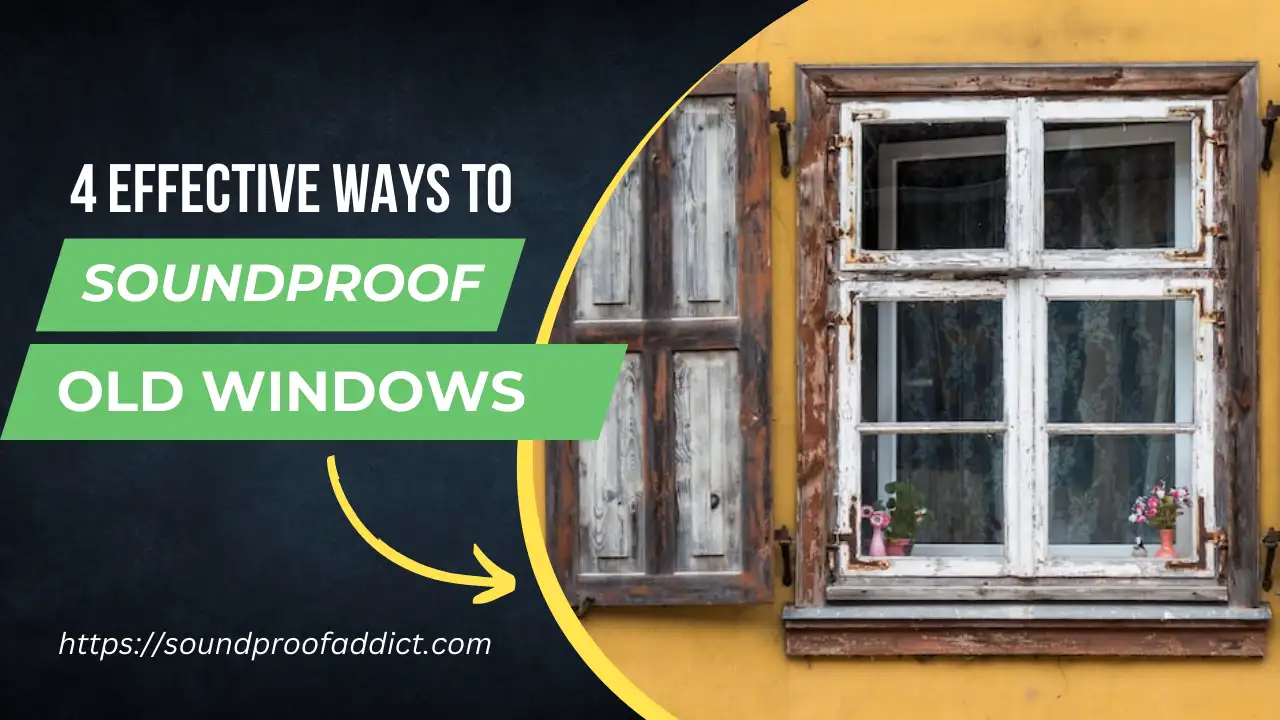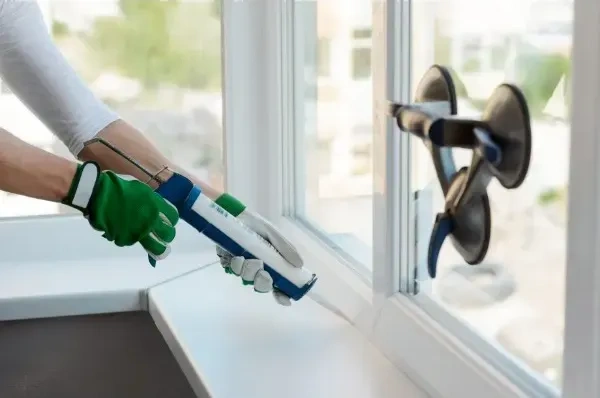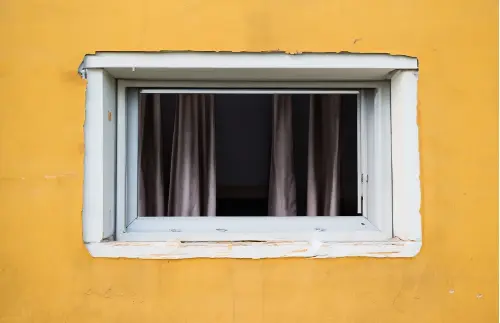How To Soundproof an Old Window? 4 Effective Ways

Well, if you have old windows in your room then there is a higher chance that you may be frustrated with the loud street noise, your neighbor’s barking dog, kids playing etc.
So, if your old windows are the source of noise pollution, then soundproofing them might be the perfect solution for you.
But honestly speaking—soundproofing old windows is not a piece of cake. As windows age, they start to develop cracks and leaks that allow noise to get into your space.
However, we will make it easy for you as today we’re going to talk about some tried-and-tested ways to soundproof an old window.
Read on to learn more.
What is the typical age range at which a window is considered “old”?
Well, first let me tell you that windows does not have don’t have an exact expiration date, but they do age, just like fine wine (minus the tastiness).
The lifespan of windows is influenced by various factors. The quality and type of materials used in their construction is the biggest factor in my opinion.
Additionally, not to mention that environmental conditions like extreme temperatures, humidity, and exposure to sunlight can also have an impact on how long windows last.
What are the effects or changes that occur when a window becomes old?
As your windows age, several effects or changes can occur, impacting your daily life and the overall condition of your home. Here are some of them:
- Increased drafts and air leakage: Over time, the seals and weather-stripping on your windows may wear out, letting drafts and unwanted air enter your home. You may start feeling uncomfortable drafts near the windows and notice a decrease in energy efficiency.
- Reduced insulation: Older windows often lack advanced insulation features found in modern designs. This can result in temperature imbalances throughout the year, with certain areas of your home feeling too hot or too cold.
- More external noise: Outdated window technology may not effectively block out external noise, making your living space noisier. If you live in a noisy neighborhood or near busy streets, you may experience constant disturbances that affect your peace and quiet.
- Increased condensation and moisture problems: Inadequate insulation and deteriorating seals can lead to condensation buildup on your windows. This excess moisture can create an environment conducive to mold growth and potentially damage the surrounding areas.
- Difficult operation: You may have noticed it. With age, your windows may become more challenging to open or close smoothly like it was before. Warped frames, damaged hardware, or general wear and tear can make operating the windows a hassle, requiring extra effort or becoming completely non-functional.
- Outdated aesthetics: The appearance of your windows may become outdated and no longer align with your desired style or enhance the curb appeal of your home. This can affect the overall aesthetics and visual appeal of your property.
4 Effective Ways To Soundproof an Old Window
So, now let’s delve into these methods and find out how to soundproof an old window effectively!
1: Use Window Inserts

If you’re seeking an effective way to soundproof your old windows, window inserts can be a suitable solution. These inserts are like secondary window that you install over your existing windows to provide an additional layer of insulation and soundproofing.
These window inserts are best option for soundproofing a noisy window. Window inserts are typically made from materials such as acrylic, polycarbonate, or glass, known for their effective sound-dampening properties.
They work by creating a dead air space between the insert and the original window, effectively absorbing and reducing external noise.
One significant advantage of window inserts is their easy removal and storage when not in use. This allows you to enjoy the benefits of soundproofing without making permanent alterations to your windows.
And, did you know? These window inserts can also provide additional insulation, helping to reduce heating and cooling costs.
The cost of noise-proofing window inserts depends mostly on your window size and material. On average, you can expect to pay around $150 to $800 per window for soundproof window inserts. By the way, the actual costs may differ depending on your specific requirements.
So, if you’re wondering how to soundproof an old window, in my perspective, window inserts are definitely worth considering especially if you want to soundproof the window without replacing it entirely.
2: Find and seal cracks or gaps with acoustic caulk
One simple yet cost-effective method of soundproofing an old window is finding and sealing cracks or gaps with acoustic caulk. Not to mention that gaps or cracks are pretty common for old windows.
These gaps and cracks are the primary culprits of letting sound pass through your windows. By finding and sealing these areas, you can reduce noise infiltration.
Firstly, you should identify any gaps or cracks present in your window frame, sash, and jambs. Look for small openings around the window where you can feel the draft or see daylight coming through.

Once you’ve found the gaps and cracks, choose a good-quality acoustic caulk. I would recommend you choose a Latex-based acoustic caulk. This type of caulk will remain flexible and won’t shrink, crack, or detach from the surfaces over time. It also helps improve sound ratings.
To apply the acoustic caulk, use a caulking gun to put a steady, even bead of caulk over the cracks or gaps you found earlier. Make sure you fill in all gaps and cracks completely and smoothly.
After you’ve applied the caulk, use a putty knife or your finger to smooth it out nicely. Don’t forget to wipe off any excess caulk, and let the caulk dry for at least 24 hours before painting over it or taking further actions.
Sealing cracks and gaps is a crucial step in soundproofing old windows. By using acoustic caulk to seal these areas, you can prevent noise infiltration and maintain a quieter environment in your home.
Recommended to read: Best Way for soundproofing a sliding window
3: Install Soundproof Curtain

Installing a soundproofing curtain is undoubtedly one of the easiest and cost-effective ways to soundproof an old window in an apartment. I think I don’t need to tell you what soundproof curtains are.
This is very popular due to its ease of installation, affordability and somewhat effectiveness. These curtains absorb sound waves and prevent them from passing through them.
Installing them is literally a piece of cake. All you need to do is just measure the length and width of your window and purchase one of the correct size. Once you have the curtain, hang it over the window using a curtain rod. That’s it.
However, you may already know that soundproof curtains can not completely eliminate all noise. But they can be a good choice if you live in a particularly noisy area, and you may want to consider additional methods such as window inserts.
If you want to get the best result from these curtains, consider choosing one with at least 3 layers or more. The number of layers in the curtain largely determines its noise reduction capabilities. As a general rule, a higher number of layers results in better noise reduction performance.
In my opinion, soundproofing curtains are particularly suitable for soundproofing windows in rental properties, sash windows soundproofing, and for bay windows noise-proofing.
4: Replace your old window with a soundproof window
If you’ve exhausted other soundproofing methods for your old windows without success, it may be worth considering the option of replacing them entirely. While this method typically involves a bigger investment, it can offer substantial benefits in terms of noise reduction.
To soundproof your old window by replacing it with a soundproof window, there are several options available. One effective choice is opting for a double or triple-pane window. (Read: Do double-pane windows worth it?)
These windows consist of multiple layers of glass, creating an additional barrier against sound transmission. The trapped air between the layers acts as an insulator, reducing noise infiltration. This method is best if you have an old single-pane window to soundproof.
When selecting a soundproof window, prioritize those with a high Sound Transmission Class (STC) rating. A higher STC rating indicates better noise-blocking capabilities. Additionally, consider choosing windows with insulated glass or low-E glass, as they contribute better to sound reduction.
The process of replacing an old window with a soundproof one varies based on the window type and installation method.
While it may be possible to undertake this as a do-it-yourself (DIY) project in some cases, it is generally recommended to hire a professional for a seamless, effective and proper installation.
Ensure you take accurate measurements of your window opening before purchasing a soundproof window.
By replacing your old window with a soundproof one, you can significantly reduce noise infiltration into your home. This creates a more peaceful and enjoyable living environment while potentially improving energy efficiency and increasing the value of your property.
Recommended to read: How can I soundproof my jalousie window?
Conclusion: Old Window Soundproofing
You now have all the necessary information about how to soundproof an old window. From the common problems with old windows to practical solutions for soundproofing them, you have learned everything you need to know to tackle this project.
If you’re looking for the most effective way to soundproof your old window, my personal recommendation will be to use soundproof window inserts.
These inserts are cost-effective, easy to install and remove, making them a convenient choice compared to replacing the entire window.
If you are willing to invest more, replacing the entire window with a double or triple-pane window is the most effective method. Although it is the priciest option, it offers significant noise reduction benefits and enhances overall comfort in your home.
Installing soundproofing curtains is a good option for those on a lower budget, and sealing the gaps and cracks in your old window should not be overlooked.
If you still have questions about how to soundproof an old window or need additional advice, don’t hesitate to leave a comment below. We love hearing from our readers and are always happy to help!
Thank you for reading this post, and best of luck with your soundproofing project!
Next to read: Soundproofing tips for Velux windows
